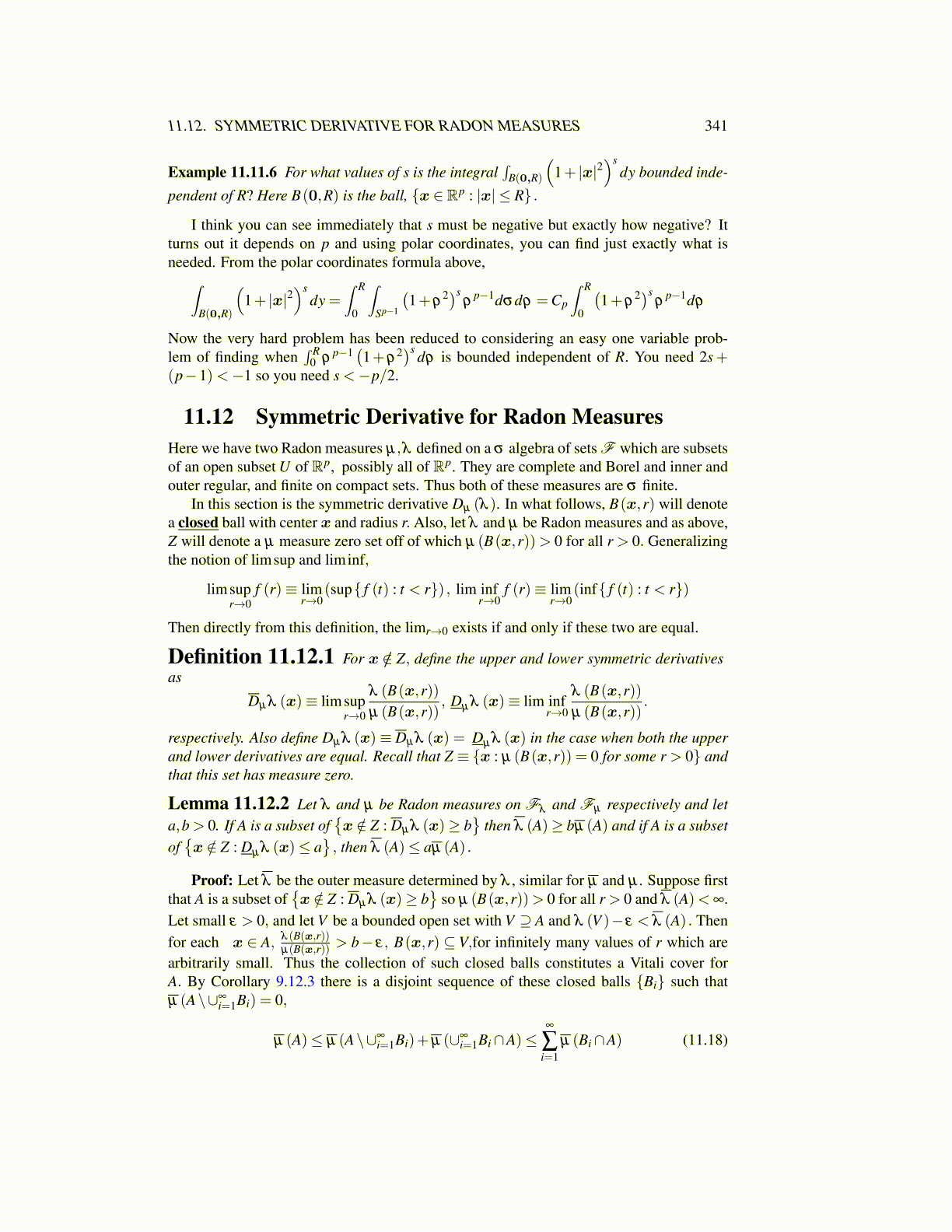
11.12. SYMMETRIC DERIVATIVE FOR RADON MEASURES 341
Example 11.11.6 For what values of s is the integral∫
B(0,R)
(1+ |x|2
)sdy bounded inde-
pendent of R? Here B(0,R) is the ball, {x ∈ Rp : |x| ≤ R} .
I think you can see immediately that s must be negative but exactly how negative? Itturns out it depends on p and using polar coordinates, you can find just exactly what isneeded. From the polar coordinates formula above,∫
B(0,R)
(1+ |x|2
)sdy =
∫ R
0
∫Sp−1
(1+ρ
2)sρ
p−1dσdρ =Cp
∫ R
0
(1+ρ
2)sρ
p−1dρ
Now the very hard problem has been reduced to considering an easy one variable prob-lem of finding when
∫ R0 ρ p−1
(1+ρ2
)s dρ is bounded independent of R. You need 2s+(p−1)<−1 so you need s <−p/2.
11.12 Symmetric Derivative for Radon MeasuresHere we have two Radon measures µ,λ defined on a σ algebra of sets F which are subsetsof an open subset U of Rp, possibly all of Rp. They are complete and Borel and inner andouter regular, and finite on compact sets. Thus both of these measures are σ finite.
In this section is the symmetric derivative Dµ (λ ). In what follows, B(x,r) will denotea closed ball with center x and radius r. Also, let λ and µ be Radon measures and as above,Z will denote a µ measure zero set off of which µ (B(x,r))> 0 for all r > 0. Generalizingthe notion of limsup and liminf,
limsupr→0
f (r)≡ limr→0
(sup{ f (t) : t < r}) , lim infr→0
f (r)≡ limr→0
(inf{ f (t) : t < r})
Then directly from this definition, the limr→0 exists if and only if these two are equal.
Definition 11.12.1 For x /∈ Z, define the upper and lower symmetric derivativesas
Dµ λ (x)≡ limsupr→0
λ (B(x,r))µ (B(x,r))
, Dµ λ (x)≡ lim infr→0
λ (B(x,r))µ (B(x,r))
.
respectively. Also define Dµ λ (x)≡ Dµ λ (x) = Dµ λ (x) in the case when both the upperand lower derivatives are equal. Recall that Z ≡ {x : µ (B(x,r)) = 0 for some r > 0} andthat this set has measure zero.
Lemma 11.12.2 Let λ and µ be Radon measures on Fλ and Fµ respectively and leta,b > 0. If A is a subset of
{x /∈ Z : Dµ λ (x)≥ b
}then λ (A)≥ bµ (A) and if A is a subset
of{x /∈ Z : Dµ λ (x)≤ a
}, then λ (A)≤ aµ (A) .
Proof: Let λ be the outer measure determined by λ , similar for µ and µ . Suppose firstthat A is a subset of
{x /∈ Z : Dµ λ (x)≥ b
}so µ (B(x,r))> 0 for all r > 0 and λ (A)< ∞.
Let small ε > 0, and let V be a bounded open set with V ⊇ A and λ (V )− ε < λ (A) . Thenfor each x ∈ A, λ (B(x,r))
µ(B(x,r)) > b− ε, B(x,r) ⊆ V,for infinitely many values of r which arearbitrarily small. Thus the collection of such closed balls constitutes a Vitali cover forA. By Corollary 9.12.3 there is a disjoint sequence of these closed balls {Bi} such thatµ (A\∪∞
i=1Bi) = 0,
µ (A)≤ µ (A\∪∞i=1Bi)+µ (∪∞
i=1Bi∩A)≤∞
∑i=1
µ (Bi∩A) (11.18)